
A platformer is a sub-genre of action video games in which the core objective is to move the player character between points in an environment. Platform games are characterized by levels with uneven terrain and suspended platforms of varying height that require jumping and climbing to traverse. Other acrobatic maneuvers may factor into the gameplay, such as swinging from vines or grappling hooks, jumping off walls, gliding through the air, or bouncing from springboards or trampolines.
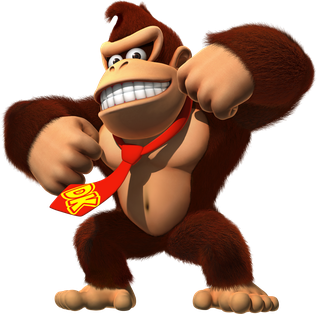
Donkey Kong, also shortened to DK, is a fictional gorilla in the Donkey Kong and Mario video game series, created by Shigeru Miyamoto. The original Donkey Kong first appeared as the title character and antagonist of the eponymous 1981 game, a platformer by Nintendo, which would lead to the Donkey Kong series. The Donkey Kong Country series was launched in 1994 with a new Donkey Kong as the protagonist. This version of the character persists as the main one up to today. While the 1980s games' Donkey Kong and the modern Donkey Kong share the same name, the manual for Donkey Kong Country and subsequent games portray the former as Cranky Kong, the latter's grandfather, with the exception of Donkey Kong 64 and The Super Mario Bros. Movie, in which Cranky is depicted as his father, alternatively portraying the modern Donkey Kong as the original Donkey Kong from the arcade games. Donkey Kong is considered one of the most popular and iconic characters in video game history.

Donkey Kong Country is a 1994 platform game developed by Rare and published by Nintendo for the Super Nintendo Entertainment System (SNES). It is a reboot of Nintendo's Donkey Kong franchise and follows the gorilla Donkey Kong and his nephew Diddy Kong as they set out to recover their stolen banana hoard from the crocodile King K. Rool and his army, the Kremlings. The single-player traverses 40 side-scrolling levels as they jump between platforms and avoid obstacles. They collect items, ride minecarts and animals, defeat enemies and bosses, and find secret bonus stages. In multiplayer modes, two players work cooperatively or race each other.

Grand Theft Auto: Vice City is a 2002 action-adventure game developed by Rockstar North and published by Rockstar Games. It is the fourth main entry in the Grand Theft Auto series, following 2001's Grand Theft Auto III, and the sixth instalment overall. Set in 1986 within the fictional Vice City, the single-player story follows mobster Tommy Vercetti's rise to power after being released from prison and becoming caught up in an ambushed drug deal. While seeking out those responsible, he gradually builds a criminal empire by seizing power from other criminal organisations in the city.

Sonic the Hedgehog is a 1991 platform game developed by Sonic Team and published by Sega for the Genesis/Mega Drive. It was released in North America on June 23 and in PAL regions and Japan the following month. Players control Sonic the Hedgehog, who can run at near supersonic speeds; Sonic sets out on a quest to defeat Dr. Robotnik, a scientist who has imprisoned animals in robots and seeks the powerful Chaos Emeralds. The gameplay involves collecting rings as a form of health, and a simple control scheme, with jumping and attacking controlled by a single button.

Banjo-Kazooie is a 1998 platform game developed by Rare and published by Nintendo for the Nintendo 64. Controlling the player characters, the bear Banjo and the bird Kazooie, the player attempts to save Banjo's kidnapped sister Tooty from the witch Gruntilda. The player explores nine nonlinear worlds to gather items and progress. Using Banjo and Kazooie's traversal and combat abilities, they complete challenges such as solving puzzles, jumping over obstacles, and defeating bosses.
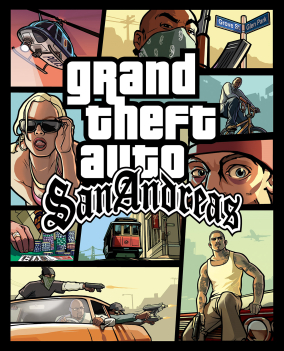
Grand Theft Auto: San Andreas is a 2004 action-adventure game developed by Rockstar North and published by Rockstar Games. It is the seventh title in the Grand Theft Auto series, following 2002's Grand Theft Auto: Vice City. Set within the fictional state of San Andreas, based on California and Nevada, the game follows Carl "CJ" Johnson, who returns home after his mother's murder and finds his old friends and family in disarray. Over the course of the game, he attempts to re-establish his old gang, clashes with corrupt authorities and powerful criminals, and gradually unravels the truth behind his mother's murder.

Diddy Kong Racing is a 1997 racing video game developed and published by Rare for the Nintendo 64. The game is set on Timber's Island and revolves around Diddy Kong and his friends' attempt to defeat the intergalactic antagonist, a wizarding pig named Wizpig, through winning a series of races. The player can take control of any of the featured characters throughout the game. Diddy Kong Racing features five worlds with four racetracks each, and the ability to drive a car, hovercraft, or pilot an aeroplane. Timber Island is loosely based on the geographical landscapes of the United States.
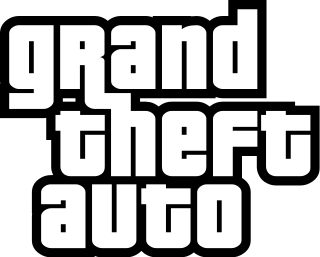
Grand Theft Auto (GTA) is a series of action-adventure games created by David Jones and Mike Dailly. Later titles were developed under the oversight of brothers Dan and Sam Houser, Leslie Benzies and Aaron Garbut. It is primarily developed by British development house Rockstar North, and published by its American parent company, Rockstar Games. The name of the series is a term for motor vehicle theft in the United States.
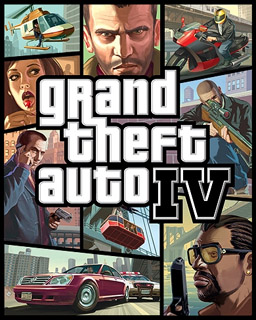
Grand Theft Auto IV is a 2008 action-adventure game developed by Rockstar North and published by Rockstar Games. It is the sixth main entry in the Grand Theft Auto series, following 2004's Grand Theft Auto: San Andreas, and the eleventh instalment overall. Set in the fictional Liberty City, based on New York City, the single-player story follows Eastern European war veteran Niko Bellic and his attempts to escape his past while under pressure from high-profile criminals. The open world design lets players freely roam Liberty City, consisting of three main islands, and the neighbouring state of Alderney, which is based on New Jersey.
Donkey Kong is a video game series and media franchise created by the Japanese game designer Shigeru Miyamoto for Nintendo. The franchise follows the adventures of Donkey Kong, a large, powerful gorilla. Donkey Kong series include the original arcade game trilogy by Nintendo R&D1; the Donkey Kong Country series by Rare and Retro Studios; and the Mario vs. Donkey Kong series by Nintendo Software Technology. Various studios have developed spin-offs in other genres such as racing and rhythm. The franchise also incorporates animation, printed media, a theme park, and merchandise.

Donkey Kong Country Returns is a 2010 side-scrolling platform game developed by Retro Studios and published by Nintendo for the Wii console. The game was released first in North America in November 2010, and in PAL regions and Japan the following month. The game's story focuses on an evil group of Tiki-like creatures known as the Tiki Tak Tribe that are unleashed on Donkey Kong Island and hypnotize the island's animals to stealing Donkey Kong and Diddy Kong's banana hoard, prompting the two to traverse the island to reclaim it.

Shenmue is an action-adventure game series created, produced and directed by Yu Suzuki. Shenmue (1999) and Shenmue II (2001) were developed by Sega AM2 and published by Sega for the Dreamcast. Shenmue III, developed by Suzuki's company Ys Net, was released for the PlayStation 4 and Windows in 2019.

Banjo-Pilot is a 2005 kart racing video game for the Game Boy Advance (GBA) and the fourth instalment in Rare's Banjo-Kazooie series. It plays similarly to the Mario Kart series by Nintendo: the player races one of nine playable characters around tracks, attacking other racers with bullets and collecting power-ups. The game features a number of single-player and multiplayer modes, such as time attack and item hunts. Unlike other kart racing games, characters control airplanes instead of go-karts.

Wreck-It Ralph is a 2012 American animated comedy film produced by Walt Disney Animation Studios and released by Walt Disney Pictures. It was directed by Rich Moore and produced by Clark Spencer, from a screenplay written by Phil Johnston and Jennifer Lee, and a story by Moore, Johnston, and Jim Reardon. John Lasseter served as the film’s executive producer. Featuring the voices of John C. Reilly, Sarah Silverman, Jack McBrayer, and Jane Lynch, the film tells the story of the eponymous arcade game villain who rebels against his "bad guy" role and dreams of becoming a hero.
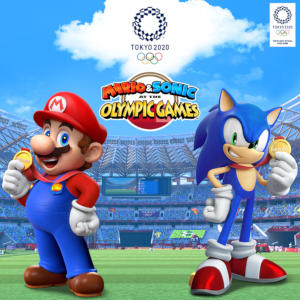
Mario & Sonic at the Olympic Games Tokyo 2020 is a 2019 sports video game based on the 2020 Summer Olympics. It is the sixth game in the Mario & Sonic series, a crossover between Nintendo's Super Mario and Sega's Sonic the Hedgehog franchises, and the first since the Rio 2016 Olympic Games edition. It was developed and published by Sega for the Nintendo Switch in November 2019 and for arcade cabinets in 2020.

Banjo & Kazooie are a pair of fictional video game characters and the eponymous protagonists of the video game series Banjo-Kazooie, created by British video game developer Rare. Banjo and Kazooie were both introduced as player characters in the original Banjo-Kazooie (1998). Banjo is a honey bear who is accompanied by Kazooie, a bird who is often seen seeking shelter in Banjo's backpack and emerging to perform various moves and attacks. The pair's numerous adventures usually pit them against the evil witch Gruntilda.















